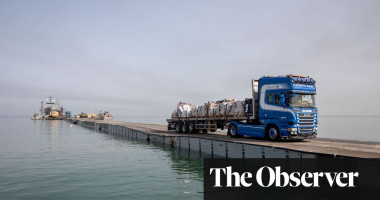‘They miscalculated’: Gaza’s floating aid pier failing to deliver in rough seas
The pier has been usable for just 12 days since it began operations on 17 May. On most of those days the assistance arriving by sea has had to be left on the beach as there have been no trucks to distribute it to warehouses in Gaza, because of lack of security.
Over the entire course of the pier’s operation so far, however, only about 250 truckloads of food and other humanitarian assistance (4,100 tonnes) have arrived by the planned maritime corridor, less than half of what would cross into Gaza in a single day before the war. Much of the aid that has arrived so far is stuck at the foot of the pier on a marshalling yard established on the beach.
The seas in the eastern Mediterranean have been choppier than expected and the pier (known by the US military as the Joint Logistics Over-the-Shore, JLOTS) has been less robust than the Pentagon planners predicted. The JLOTS floating structure is designed to work in conditions up to “sea state 3”, defined by waves of 0.5 to 1.25 metres. It was hoped it would endure through the spring and summer until September, but it was badly damaged in a storm on 25 May, and the sea has been unseasonably choppy since then.
It was put back in place on Wednesday and since then has been used to offload about 4,160 tonnes of aid, but there have been reports that, because of its vulnerability to weather and high seas, it could be dismantled once and for all ahead of schedule, as early as next month.
“They just miscalculated,” Stephen Morrison, a senior vice-president at the Center for Strategic and International Studies, said. “They didn’t fully understand what was going to happen with the weather … So the DoD [Department of Defence] walks away, humiliated in a fashion.”
